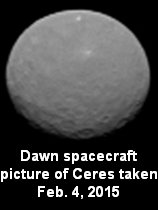¡SkyCaramba! Weekly astronomy blog for the week ending March 21, 2015
The biggest asteroid between Mars and Jupiter may hold more water than Earth. Ceres is thought to have a rocky core and a thick ice crust. Water vapor plumes, possibly coming from icy volcanoes, have been detected coming off its surface.
 Quite a lot of asteroids are oddly shaped. Astronomers describe their shapes as potatoes. Ceres happens to be round.
Quite a lot of asteroids are oddly shaped. Astronomers describe their shapes as potatoes. Ceres happens to be round.
Ceres is the first asteroid discovered. Giusseppe Piazzi spotted it on the first night of 1801. The best telescopes of the time couldn’t resolve it as anything but a dot. In that way, it was much like a star. However, it moved among the stars like a planet. Astronomers weren’t sure what to call this type of object at first, but they eventually settled on asteroid which means star-like.
The views weren’t much better by the time Heinrich Olbers discovered the fourth known and brightest asteroid, Vesta, on March 29, 1807. Astronomers were beginning to suspect there were many more such objects between Mars and Jupiter. Olbers thought they were from a planet that had been destroyed.
Vesta has a somewhat lumpy oval shape. It is believed to have an iron and nickle core with a rocky mantle. A crater at its south pole indicates something hit it long ago. Astronomers believe many pieces of Vesta that broke off are still in similar orbits. A few of these Vestoids have left the asteroid belt. One landed in Australia in 1960.
 Today’s earth-based telescopes get much better view of the asteroids. But even the Hubble Space Telescope can’t get a really clear view. Those views will come though after the release of data from the Dawn mission.
Today’s earth-based telescopes get much better view of the asteroids. But even the Hubble Space Telescope can’t get a really clear view. Those views will come though after the release of data from the Dawn mission.
The Dawn spacecraft visited Vesta in 2011 and is visiting Ceres now. Keep paying attention to the news about the mission. The mission’s scientists are still going through the data taken from the Vesta part of the mission and the Ceres data gathering is just starting.
Astronomers think there are 750,000 or more asteroids 1 kilometer wide or larger in the asteroid belt between Mars and Jupiter. There could be millions that are smaller. While it’s possible they are the debris of a planet that cracked apart, most scientists today think it’s more likely they are chunks of material that never came together to be a planet in the first place.
¡SkyCaramba!